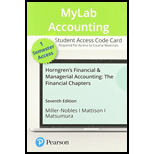
1.
Introduction:
Financial Statements: The financial statements of a company are prepared at the end of an accounting year to calculate the total liabilities, total assets, net profit or loss, and increase or decrease in cash during the year. The financial statements are used by various external and internal parties.
To prepare: The
2.
Introduction:
Financial Statements: The financial statements of a company are prepared at the end of an accounting year to calculate the total liabilities, total assets, net profit or loss, and increase or decrease in cash during the year. The financial statements are used by various external and internal parties.
To state: The accounts that will be misstated if adjusting entries are not recorded.
Want to see the full answer?
Check out a sample textbook solution
Chapter 3 Solutions
Pearson eText Horngren's Financial & Managerial Accounting: The Financial Chapters -- Instant Access (Pearson+)
- At the beginning of the year, Downtown Athletic had an inventory of $200,000. During the year, the company purchased goods costing $800,000. If Downtown Athletic reported ending inventory of $300,000 and sales of $1,050,000, their cost of goods sold and gross profit rate must be ........... The Stacy Company makes and sells a single product, Product R. Budgeted sales for April are $300,000. Gross Margin is budgeted at 30% of sales dollars. If the net income for April is budgeted at $40,000, the budgeted selling and administrative expenses are: - $133,333 - $60,000 - $102,000 - $78,000. CALIN CORPORATION HAS TOTAL CURRENT ASSETS OF $615,000, TOTAL CURRENT LIABILITIES OF $230,000, TOTAL STOCKHOLDERS' EQUITY OF $1,183,000, TOTAL PLANT AND EQUIPMENT (NET) OF $958,000, TOTAL ASSETS OF $1,573,000, AND TOTAL LIABILITIES OF $390,000. THE COMPANY'S WORKING CAPITAL ISarrow_forwardCliffside Resort has sales of $920,000 and a profit margin of 7%. The annual depreciation expense is $105,000. What is the amount of the operating cash flow if the company has no long-term debt?arrow_forwardA company can sell all the units it can produce of either Product M or Product N but not both. Product M has a unit contribution margin of $32 and takes six machine hours to make, while Product N has a unit contribution margin of $45 and takes nine machine hours to make. If there are 10,800 machine hours available to manufacture a product, income will be_. A. $3,600 more if Product M is made B. $3,600 less if Product N is made C. $2,000 less if Product M is made D. the same if either product is made.arrow_forward
- Noble Corporation had accounts receivable of $12,000 at the beginning of the month and $6,800 at the end of the month. Credit sales totaled $68,000 during the month. Calculate the cash collected from customers during the month, assuming that all sales were made on account.arrow_forwardQuentin sells a parcel of land for $80,000 cash, and the buyer assumes Quentin's liability of $12,000 on the land. Quentin's basis in the land is $65,000. What is the gain or loss he will recognize on the sale? A. $3,000 loss B. $15,000 gain C. $27,000 gain D. $37,000 gainarrow_forwardVelocity Industries used 9,200 machine hours (Driver) on Job #45. Total machine hours are 28,000. Assume Job #45 is the only job sold during the accounting period. If the total overhead applied is $196,000, what is the overhead applied in COGS?arrow_forward
- Tony sold a building to Carol. The sales price was $420,000. Tony paid a commission to a real estate broker of $22,000 and paid other selling expenses of $5,800. Tony's basis in the building was $285,000. What was Tony's gain realized on the sale of the building?arrow_forwardLila Corporation reported net sales of $80,000. The beginning accounts receivable was $15,000, and the ending accounts receivable was $21,000. What is the days sales collected for Lila Corporation? (Rounded answer to nearest day)arrow_forwardEleanor Technology, a firm with no net debt, reports cash flow from operations of $7,840 million in its cash flow statement after adding $2,250 million in accruals to earnings. It reported cash investments in operations of $4,680 million. What were Eleanor Technology's free cash flow and earnings for the period? Help me with thisarrow_forward
- Kaiser Industries earned an operating income of $35,500 with a contribution margin ratio of 0.40. Actual revenue was $320,000. Calculate the total fixed cost. Round your answer to the nearest dollar, if required.arrow_forwardProvide correct option accounting questionarrow_forwardA business has revenue of $895,000, cost of goods sold of $356,000, operating expenses of $198,000, and pays $82,000 in taxes, what is the net income?arrow_forward
